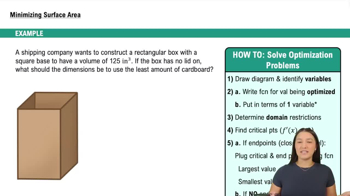Find the volume of the torus formed when the circle of radius 2 centered at (3, 0) is revolved about the y-axis. Use geometry to evaluate the integral.
Table of contents
- 0. Functions7h 54m
- Introduction to Functions16m
- Piecewise Functions10m
- Properties of Functions9m
- Common Functions1h 8m
- Transformations5m
- Combining Functions27m
- Exponent rules32m
- Exponential Functions28m
- Logarithmic Functions24m
- Properties of Logarithms36m
- Exponential & Logarithmic Equations35m
- Introduction to Trigonometric Functions38m
- Graphs of Trigonometric Functions44m
- Trigonometric Identities47m
- Inverse Trigonometric Functions48m
- 1. Limits and Continuity2h 2m
- 2. Intro to Derivatives1h 33m
- 3. Techniques of Differentiation3h 18m
- 4. Applications of Derivatives2h 38m
- 5. Graphical Applications of Derivatives6h 2m
- 6. Derivatives of Inverse, Exponential, & Logarithmic Functions2h 37m
- 7. Antiderivatives & Indefinite Integrals1h 26m
- 8. Definite Integrals4h 44m
- 9. Graphical Applications of Integrals2h 27m
- 10. Physics Applications of Integrals 3h 16m
- 11. Integrals of Inverse, Exponential, & Logarithmic Functions2h 34m
- 12. Techniques of Integration7h 41m
- 13. Intro to Differential Equations2h 55m
- 14. Sequences & Series5h 36m
- 15. Power Series2h 19m
- 16. Parametric Equations & Polar Coordinates7h 58m
9. Graphical Applications of Integrals
Introduction to Volume & Disk Method
Problem 6.6.23c
Textbook Question
Determine whether the following statements are true and give an explanation or counterexample.
c. Let f(x)=12x^2. The area of the surface generated when the graph of f on [−4, 4] is revolved about the x-axis is twice the area of the surface generated when the graph of f on [0, 4] is revolved about the x-axis.
 Verified step by step guidance
Verified step by step guidance1
Recall the formula for the surface area generated by revolving a curve \(y = f(x)\) about the x-axis over the interval \([a, b]\):
\[S = \int_a^b 2\pi f(x) \sqrt{1 + (f'(x))^2} \, dx\]
Identify the function and its derivative:
Given \(f(x) = 12x^2\), then
\[f'(x) = 24x\]
Set up the surface area integrals for both intervals:
For \([-4, 4]\):
\[S_1 = \int_{-4}^4 2\pi (12x^2) \sqrt{1 + (24x)^2} \, dx\]
For \([0, 4]\):
\[S_2 = \int_0^4 2\pi (12x^2) \sqrt{1 + (24x)^2} \, dx\]
Analyze the integrand's symmetry:
Since \(f(x) = 12x^2\) is an even function and \(f'(x) = 24x\) is an odd function, the term inside the square root, \$1 + (f'(x))^2 = 1 + (24x)^2\(, is even. The product \)f(x) \sqrt{1 + (f'(x))^2}$ is therefore even because it is the product of an even function and an even function.
Use the property of even functions in integrals:
For an even function \(g(x)\),
\[\int_{-a}^a g(x) \, dx = 2 \int_0^a g(x) \, dx\]
Therefore,
\[S_1 = 2 S_2\]
This shows that the surface area generated on \([-4,4]\) is twice the surface area generated on \([0,4]\), confirming the statement.
 Verified video answer for a similar problem:
Verified video answer for a similar problem:This video solution was recommended by our tutors as helpful for the problem above
Video duration:
5mPlay a video:
Was this helpful?
Key Concepts
Here are the essential concepts you must grasp in order to answer the question correctly.
Surface Area of Revolution
The surface area generated by revolving a curve y = f(x) about the x-axis over an interval [a, b] is found using the formula S = ∫ from a to b 2π f(x) √(1 + (f'(x))^2) dx. This integral accounts for the circumference of circular slices and the curve's slope, providing the total surface area.
Recommended video:

Example 1: Minimizing Surface Area
Symmetry of Functions and Intervals
When a function is even (f(-x) = f(x)) and the interval is symmetric about zero, properties of symmetry can simplify calculations. For surface areas, symmetry does not always imply the surface area over [-a, a] is twice that over [0, a], because the integrand may not be an even function.
Recommended video:

Properties of Functions
Derivative and Its Role in Surface Area
The derivative f'(x) measures the slope of the function and affects the surface area integral through the term √(1 + (f'(x))^2). This term adjusts the length element to account for the curve's steepness, influencing the total surface area generated by revolution.
Recommended video:

Example 1: Minimizing Surface Area

 5:38m
5:38mWatch next
Master Introduction to Cross Sections with a bite sized video explanation from Patrick
Start learningRelated Videos
Related Practice
Textbook Question
27
views
